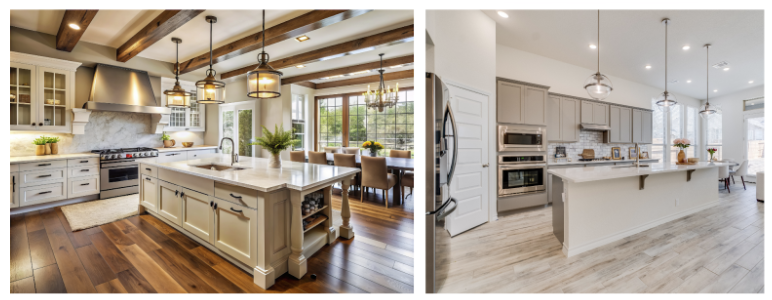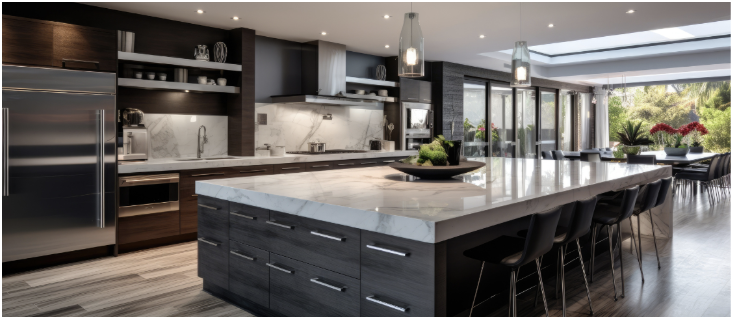
When designing or remodeling a kitchen, one of the most significant decisions is choosing between a traditional or contemporary style. Each design embodies distinct characteristics, aesthetics, and functionality that can shape the atmosphere of your home. This blog post will delve into the defining features, advantages, and drawbacks of both styles to help you make an informed choice.
Overview of Traditional Kitchens
Traditional kitchens exude warmth, comfort, and classic charm. They are often inspired by designs from past centuries, incorporating elements that evoke a sense of history and elegance. Key features include:
Cabinetry and Woodwork: Traditional kitchens typically feature raised-panel or decorative cabinets with intricate molding and detailing. Woods such as oak, cherry, and mahogany are popular choices, often finished with rich, warm stains.
Colors and Palettes: Neutral tones dominate traditional kitchens, including whites, creams, beiges, and earthier hues. These palettes provide a timeless appeal and can be paired with subtle color accents for variety.
Materials and Surfaces: Natural materials play a significant role in traditional kitchens. Think granite or marble countertops, stone backsplashes, and natural hardwood floors. These materials contribute to the overall sense of luxury and durability.
Lighting: Chandeliers, pendant lights with ornate detailing, and classic wall sconces create an inviting and well-lit space.
Decor and Accents: Crown molding, corbels, glass-front cabinets, and decorative hardware add an extra touch of sophistication.
Advantages of Traditional Kitchens
Timeless Appeal: Traditional kitchens are unlikely to go out of style, providing long-term value and a classic look.
Warmth and Comfort: The use of warm tones and natural materials fosters an inviting atmosphere.
Custom Details: Traditional design allows for custom embellishments that add character and personal touches.
Drawbacks of Traditional Kitchens
Cost: High-quality materials and intricate detailing can make traditional kitchens more expensive to design and install.
Maintenance: Natural surfaces like marble require regular upkeep to maintain their appearance.
Potential for Overcrowding: The intricate designs and embellishments can sometimes create a more cluttered appearance.
Overview of Contemporary Kitchens
In contrast, contemporary kitchens are defined by their sleek, clean lines, minimalist aesthetics, and forward-thinking design. They often reflect the current trends in architecture and technology, blending simplicity with function. Key features include:
Cabinetry and Storage: Contemporary kitchens feature frameless cabinets, flat-panel doors, and built-in storage solutions that maximize space. The cabinetry is often smooth and uninterrupted, creating a seamless look.
Colors and Palettes: Contemporary designs favor a mix of bold and muted color schemes, such as white, black, gray, and pops of vibrant hues like teal or yellow. Matte and glossy finishes can be used to add depth.
Materials and Surfaces: Engineered materials like quartz and stainless steel are popular in contemporary kitchens. Modern laminates, concrete countertops, and glass backsplashes add a cutting-edge feel.
Lighting: Recessed lighting, LED strips, and pendant lights with minimalist designs are common, offering both functionality and an elegant aesthetic.
Decor and Accents: Minimalism is key in contemporary kitchens. Decorative elements are kept to a minimum to highlight the streamlined nature of the design. Sleek, understated hardware, open shelving, and hidden appliances contribute to the overall look.
Advantages of Contemporary Kitchens
Simplicity and Elegance: The uncluttered and open look of contemporary kitchens provides a sense of space and order.
Low Maintenance: Engineered materials are often more durable and easier to clean than their natural counterparts.
Innovative Features: Contemporary kitchens often incorporate the latest technology, such as smart appliances and integrated lighting systems.
Drawbacks of Contemporary Kitchens
Potential for Coldness: Without careful attention, contemporary kitchens can feel sterile or less inviting.
Trend-Dependent: Contemporary designs may need updates more frequently to keep up with shifting trends.
Limited Customization: The minimalist approach can restrict personalization and character compared to traditional designs.
Key Differences Between Traditional and Contemporary Kitchens
Design Philosophy: Traditional kitchens embrace detailed craftsmanship and timeless elegance, while contemporary kitchens prioritize minimalism and sleekness.
Materials: Traditional kitchens rely heavily on natural materials like stone and wood, whereas contemporary kitchens incorporate engineered options such as quartz and stainless steel for a modern finish.
Color Schemes: The palette of a traditional kitchen is generally warm and neutral, creating a cozy environment, whereas contemporary kitchens favor a range of options, from monochromatic schemes to bold accent colors.
Storage Solutions: While traditional kitchens may feature glass-front cabinets and display shelving, contemporary kitchens lean toward hidden storage solutions to enhance a clean, uncluttered look.
Lighting: Traditional kitchens use decorative and classic fixtures, while contemporary kitchens emphasize recessed or linear lighting for a modern glow.
Decor: Traditional designs feature intricate moldings and embellishments, whereas contemporary kitchens focus on simplicity and function, minimizing decorative elements.
Making Your Choice
When deciding between a traditional or contemporary kitchen, consider the following factors:
Your Home’s Style: A traditional kitchen may fit seamlessly in an older home with historic architecture, while a contemporary kitchen can complement a modern, open-concept space.
Personal Taste: If you appreciate classic beauty, custom details, and warm aesthetics, a traditional kitchen might be for you. On the other hand, if you prefer clean lines, innovative technology, and a minimalist approach, a contemporary kitchen could be your ideal choice.
Budget: Traditional kitchens, with their natural materials and intricate designs, often require a higher budget. Contemporary kitchens can sometimes be more cost-effective due to their streamlined construction and use of engineered materials.
Lifestyle: Families who spend a lot of time in the kitchen might appreciate the warmth and welcoming feel of a traditional design. Contemporary kitchens, with their easy-to-clean surfaces and smart features, might appeal more to busy individuals who prioritize efficiency.
Blending the Two Styles
For those who appreciate aspects of both styles, a transitional kitchen may be the perfect compromise. Transitional kitchens merge the warmth and detailing of traditional kitchens with the simplicity and function of contemporary spaces. This can include elements such as shaker-style cabinets in a neutral color palette, quartz countertops, and a mix of classic and modern lighting.
Final Thoughts
Whether you choose a traditional or contemporary kitchen, the goal is to create a space that feels cohesive with the rest of your home and reflects your personality and lifestyle. Both styles have their strengths and can be customized to meet your needs. With thoughtful planning, your dream kitchen—be it timelessly traditional, sleekly contemporary, or somewhere in between—can become the heart of your home.
Subscribe to Cabinet Wholesalers's Blog









Comments